Recruits against Napoleon
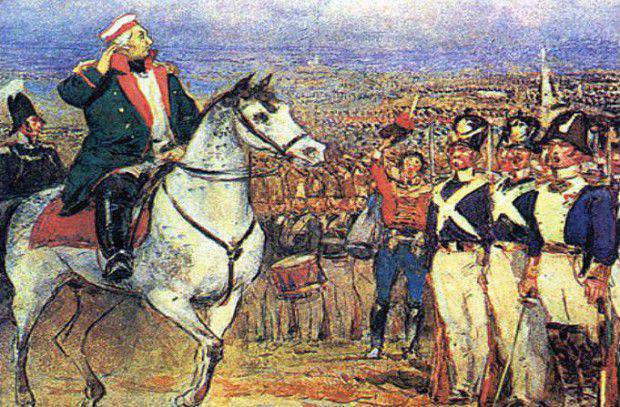
As recruited soldiers of the Russian army in the era of Suvorov and Kutuzov
The Russian Planet already wrote about the creation by Peter I of the recruitment service system, which not only allowed to win the war with Sweden, but also made the Russian army the strongest in Europe. Now the story of how our army was provided by ordinary soldiers in the era of its most glorious victories - in the times of Suvorov and Kutuzov.
Recruits Peter's heirs
The death of the king-reformer somewhat reduced the military tension in the empire. In 1728, in order to alleviate the situation of the peasants for the first time in a quarter of a century, they did not recruit for the first time, and the following year, a third of the army soldiers and officers were released on 12 months.
In 1736, a slightly increased recruitment was made due to the war against Turkey - for 1 people with male 125 souls, as a result, about 45 thousands of recruits were taken into the army that year (instead of the usual 20 – 30 thousands of recruits per year). In 1737, for the first time, they recruited Muslim peasants.
From 1749 to 1754, under Empress Elizabeth Petrovna, there were no recruitment kits for five years. And only in 1755, because of the impending war against Prussia, they carried out an intensified set - on 1 to the person with 100 souls who gave 61 to 509 recruits.
In 1757, field marshal Pyotr Shuvalov introduced the “General Institution on the Recruitment Annual Collection”, according to which all ten Russian provinces of that time were divided into five recruit districts in order to recruit from every district every five years. In this case, from the Arkhangelsk province recruits were supposed to take only the fleet.
For all the time of the war with Prussia from 1756 to 1759, a thousand recruits were taken into the army by 231 for the year, and from 1760 there were no recruits in the country again. In the 1766 year, already under Empress Catherine II, they approved "the General Institution on the collection of recruits in the state and on the procedures that must be performed when recruiting." This document for more than half a century, until the end of the war with Napoleon, determined the order of recruitment.
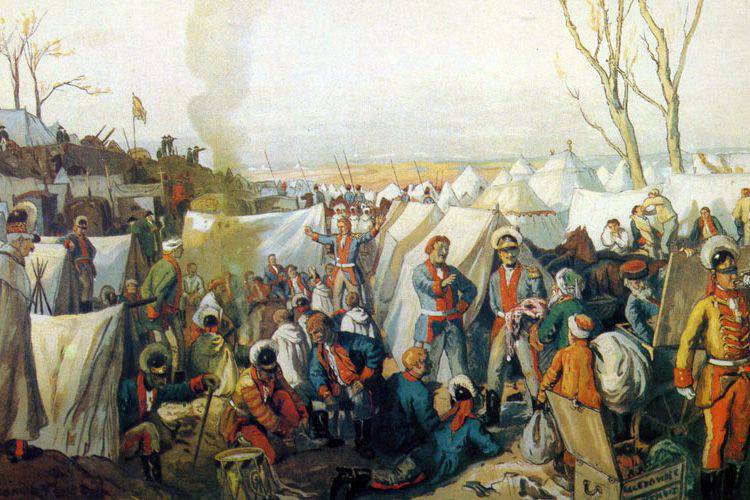
By that time, the traditions and customs of the “recruitment” had already been established - the supreme power only lowered the general plan of recruitment with the number of recruits, and then the peasant communities independently chose candidates for life-long service in accordance with their ideas of justice.
Before each set of recruits, army officers who arrived in the county towns formed “recruit sites”, breaking up the rural population on the male 500 souls according to previous “revisions” (i.e. censuses). This process throughout the next century was called the “recruitment layout”. Then the peasant communities of these sites themselves chose future recruits by lot.
Only certain categories of peasants, for example, families with a single breadwinner, were exempted from such a draw. Families that had many adult sons, on the contrary, were put first “on the recruit queue”, and it was from them that lots were chosen for the recruit in the case of the usual “number” recruitment sets. In the case of extraordinary and extraordinary raised sets "on the recruitment queue" and the toss was put everything.
On the eve of the Russian-Turkish war of 1768 – 1774, three sets of recruits were held, taking thousands of people into the army of 74, including for the first time they began to call for schismatics. The war with the Turks was difficult, and 1770 thousands of recruits were assembled in 1773 – 226 for reinforced military sets. But because of the uprising of Pugachev and the unrest of the peasants in the next two years, recruits were not held.
Before the start of the next war, kits were based on the recruitment of 1 recruits from 500 souls. In 1788, the government, due to the new war, immediately decided to increase the army with both Turkey and Sweden. Now, we began to take on 5 people with 500 male peasant souls, that is, we increased the rate of recruitment by five times, and in the next three years 260 thousands of recruits were taken into the army.
In 1791 – 1792, there were no kits, and in the last eight years of the 18th century, 311 thousands of people were recruited into the army. If in the first half of that century, the term of military service was still for life, then from 1762, it was limited to 25 years. Taking into account the average life expectancy and almost constant wars, this period was actually for life, but at least theoretically allowed a small percentage of the most successful soldiers to enter the honorable resignation.
It was here that the brutal, but extremely successful “recruit” effect was hidden - a man who ended up in the army class would inevitably either die or become a very experienced soldier. In the era of pre-industrial warfare, it was these lifelong, highly experienced soldiers who constituted the main force of the Russian army. It was with them "not by number, but by skill" that Suvorov defeated the enemy!
In total, over the XVIII century more than 2 million people were taken into the army - namely, 2 231 000 recruits. Every 15 adult man in the country got into life service.
Recruit rite
Over the century of the existence of recruitment duties, it has become an integral part of the life of a Russian village. Until the middle of the XIX century, there were three main rituals in the life of the peasants - wedding, funeral and recruit.
The ethnographers of the end of the XIX century, according to the old men, still managed to record the details of this custom. After the peasant's son at a meeting pulled out the lot of the recruit, relatives and guests gathered at his house for what the peasants called “sad feast”. In fact, it was a kind of wake for a recruit, who was no longer destined to return to his native village.
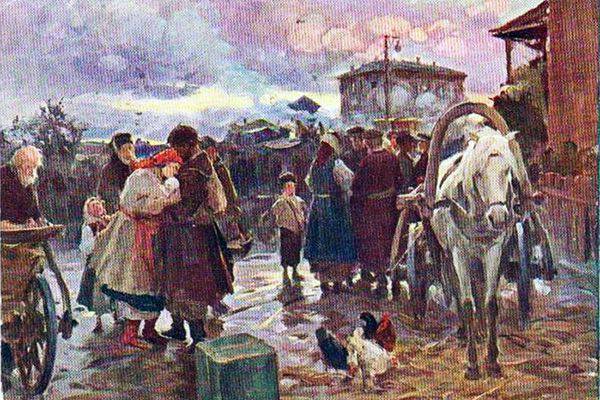
At the “sad feast,” relatives and invited mourners, “voopennitsy” sang recruiting cries - special folk songs-lamentations. Such crying was not so much sung, they were rather chanting, with particular anguish. One of them was recorded in the XIX century in the territory of the Novgorod province. We give a short excerpt, keeping the spelling of the original:
And the service of the Gosudarev was formidable,
And svolnovalsya enemy of the Russian land,
And they began to send decrees of the State,
And they began to collect good, good fellows.
How to gather for now and for the quality!
And here they began to write good, kind fellows
Yes on this stamp sheet, piece of paper
And judges began to call unjust
And all this etym dubovim lots!
And they took the stallions of the oaks:
And we must go here in the service of the Gosudarev!
After the “sad feast” for the future recruit, “rampant” began - for several days he drank, walked in plenty and rode in a dressed cart with girlfriends and friends in the village. As the ethnographer of the nineteenth century wrote: “At the same time, not only it was not considered reprehensible to drink alcohol, but even, as it were, mandatory.”
Then the farewell to the family began - the future recruit traveled to all close and distant relatives, where for him and the guests there was always a "feasible treat". After that, accompanied by the entire village, a recruit went to church for a solemn prayer service, candles were set for his good luck and health. From here, the recruit was escorted to the county town, where his life-long soldiers' journey began.
In a huge country with undeveloped means of communication, the soldiers were considered to be a “state man”, that is, completely missing for the former peasant and petty bourgeois world. There were a number of sayings that reflected the situation when a recruit, in fact, disappeared forever from the lives of loved ones: “To the recruitment - to the grave”, “The Soldier - cut off the chunk” and others.
But we also note another social role of “recruiting”. Until the middle of the XIX century, only she gave the serf peasant at least a theoretical opportunity to dramatically improve their social status: becoming a serf soldier of the empire, he was able to reach the officer rank and noble rank. Let luck smiled only to units from many tens of thousands, but Russian story knows examples of such “careers” - according to statistics, on the eve of 1812, every hundredth officer of the Russian army was from the exhausted peasant recruits.
Until the beginning of the XIX century, the state did not interfere in the “practical layout” of recruitment service, that is, in the election of the peasant community of candidates for recruits. And the peasantry actively used it, first of all handing over to the recruits negligent fellow villagers, who were distinguished by "every kind of riot" and "fragility in the economy." Only 28 on April 1808 of the year issued a decree regulating the return of "secular society" to the recruits of its members for "bad behavior." From now on, the "public sentences" of the peasants were to be checked and approved in the offices of the governor.
At the very end of the 18th century, permanent “Five Hundred Sections” were introduced instead of the old temporary ones that were formed anew before each new recruitment. These sites consisted of 500 “male revision souls,” that is, five hundred peasants recorded by the previous “revision.” In the counties were established "recruiting presence" - in fact, these military registration and enlistment offices.
It is in this state that the recruit system of the Russian army met the era of the war with Napoleon.
Recruits Napoleonic Wars
On the eve of the Napoleonic wars, for one reason or another, the law freed up almost 20% of the male population of Russia. In addition to the nobility, the clergy, merchants and a number of other classes and groups of the population were completely freed from the “recruitment”.
In 1800 – 1801, there were no recruitment kits in the country. In 1802, the first in the XIXth century and 73, in a row, the next recruitment set was made from the 2 recruitment layout with 500 souls and gave the 46 491 recruit. However, in the 1805 year, because of the war with Napoleon, recruitment was increased to 5 people with 500 souls, 168 thousands of recruits were collected that year.
In 1806 – 1807, the ongoing war with Napoleon and the outbreak of the war with Turkey forced to convene a militia of 612 thousand warriors (although in reality they collected only 200 thousand people). Most of these temporary militias - 177 thousands, despite their resistance, were left in the army as recruits.
In 1809 – 1811, reinforced kits were coming because of the threat of war with France — 314 recruited thousands of recruits. In the fateful 1812 year, three sets passed - 82, 83, and 84. The first set that year was declared an imperial decree even before the beginning of the 23 war in March, the second - 4 in August, the third - 30 in November. At the same time, emergency recruits in August and November followed an increased rate — 8 recruits from 500 souls.
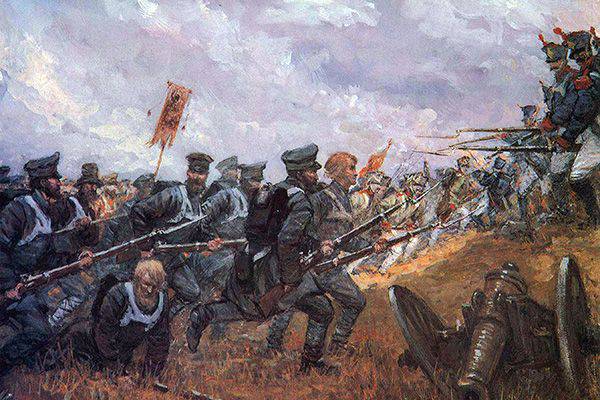
A heavy bloody war with almost all of Europe mobilized by Napoleonic marshals required constant army reinforcements, and the recruitment sets in August and November 1812 were marked by a sharp decrease in requirements for recruits. Previously, in accordance with the “General Assembly for Recruitment in the State of Recruit” from 1766, the army was taken “healthy, strong and fit for military service, from 17 to 35 years, 2 arshina 4 cm” In 160, the same year they began to accept all no older than 1812 years and no less than 40 arshin 2 vertices (2 cm). At the same time they were allowed to recruit people with bodily defects, with whom they had not previously taken to the army.
In the midst of the struggle with Napoleon, the War Department allowed admitting to recruitment kits: “Rare-haired, odd-eyed and oblique, if only their sight allows you to aim with a gun; those who have white eyes or spots on the left eye, so that the right eye is completely healthy; stutter and tongue-tied could be explained in any way; not having up to six side teeth, if only they were intact, necessary for cutting the cartridges; with the lack of one toe, just to walk freely; having on one left hand any kind of flattened finger that does not interfere with charging and operating a gun ... ”.
In just a year, 1812 recruited about 320 thousands of people into the army. In 1813, the next, 85 th recruitment was announced. He also walked along the increased military standard 8 recruits with 500 souls. Then, for the army, which went on a foreign campaign to the Rhine, almost 200 thousands of recruits were gathered.
"Recruit" after the Napoleonic Wars
At the end of the Napoleonic Wars, recruitment kits were reduced, but still remained significant. From 1815 to 1820, thousands of people were taken into the army by 248. But in the next three years, recruits were not recruited. Only in 1824-m scored on 2 people with 500 souls - just 54 639 people.
Thus, in the first quarter of the 19th century, almost 1,5 million recruits were taken into the army (8% of the total male population). Among them, over 500, thousands of recruits were drafted into the army during the 1812 – 1813 war.
After 1824, several years there were no sets again, and the next one took place only three years later. In connection with the new war against Turkey and the uprising in Poland in 1827 – 1831, 618 thousands of recruits were recruited into the army.
Emperor Nicholas I was inclined to regulate all aspects of life, and 28 June 1831, the most detailed "Charter of the Recruits" appeared. In the imperial decree, the necessity of adopting such a charter was motivated by “complaints repeatedly received” about riots and disputes during recruitment appeals. From now on, the 497 articles of this document carefully regulated all parties of the recruitment set. The whole country was divided into “recruit sites” for a thousand “audit souls”.
In the 1832 year, they waited for the introduction of this new charter, so recruiting was not conducted, only 15 639 people from the previously non-recruited Jews in the western provinces of the empire gathered. In 1834, a royal decree was issued to reduce the terms of the soldier’s service from 25 to 20 years.
By the decision of Emperor Nicholas I, the whole country was also divided into the Northern and Southern halves, in which from now on the annual recruitment sets alternated. All the Baltic, Byelorussian, central, Ural and Siberian provinces entered the Northern half. In the South - all the provinces of Ukraine, Novorossia, and Astrakhan, Orenburg, Oryol, Tula, Voronezh, Kursk, Saratov, Tambov, Penza and Simbirsk provinces. Over 20 years before the start of the Crimean War in 1833 – 1853, over a million recruits were taken into the army - 1 345 000 people.
The Crimean War with the coalition of the West once again raised the norms of recruitment sets. In 1853, thousands of people were taken to the army by 128; in 1854, three sets were already taken - 483, thousands of recruits. In the 1855 year, 188 thousand more were collected. 50 – 70 people were recruited from every thousand “revision souls”, that is, the recruitment proportion was three times heavier than in the 1812 year (when, we recall, from a thousand souls, 16 people were taken maximum).
Thus, in the course of the Crimean War for three years 799 thousand people were taken into the army.
From "recruitment" to universal appeal
After the Crimean War, the next seven years, from 1856 to 1862, recruits were not held in Russia at all - this privilege for ordinary people was declared the coronation manifesto of Emperor Alexander II.
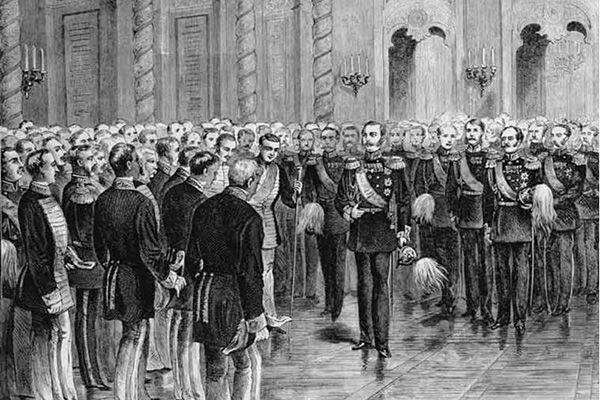
During this time, in 1861, serfdom was abolished, which effectively eliminated the social foundations of the "recruitment". At the same time, more and more opinions appeared among the Russian military for introducing any alternative to the recruiting conscription. First, the “recruitment” forced the state to maintain a huge professional army in peacetime, which was extremely expensive even for the big Russian Empire. Secondly, the system of recruiting sets, allowing the regular army to be successfully completed during the "ordinary" wars, due to the lack of a trained reserve, made it impossible to quickly increase the number of troops during a major war such as Napoleonic or Crimean.
All this forced the generals of Alexander II for a decade after the abolition of serfdom to develop numerous projects of changes and alternatives to the recruitment system. So, back in 1859, the term of the soldier’s service in several receptions was reduced to 12 years.
However, the inertia of the huge system was great, and the recruitment kits continued. In the 1863 year, due to the uprising in Poland and the anticipated intervention of the Western powers, two emergency recruitments were made, according to 5, a person with a thousand souls. Then the army took 240 778 people.
Further recruitment kits were made annually, for 4 – 6 people with a thousand souls. These kits gave 140 to 150 thousands of recruits per year. In total, over the last decade of the existence of recruitment duties, from 1863 to 1873 a year, 1 323 340 recruits were recruited into the army.
The final recruitment duty in Russia was abolished only when the big war in Western Europe demonstrated that the conscription system of military service in conjunction with the railways that appeared allowed in peacetime to abandon the permanent maintenance of a large professional army without appreciable damage to the country's combat capability. In 1870, the rapid mobilization of the Prussian army for war with France was personally observed by the Russian Minister of the Interior in Germany, the de facto head of government, Peter Valuev.
The mobilization, her thoughtful lightning speed and the quick rout of France made a great impression on the Russian minister. Returning to Russia, Valuev together with the head of the military department Dmitry Milyutin prepared an analytical note for the tsar: “Russia's security requires that its military structure does not lag behind the level of the armed forces of its neighbors.”
As a result, the authorities of the Russian Empire decided to completely abandon the recruitment recruitment system that had existed since Peter’s time. 1 January 1874 of the year appeared the royal manifesto, which introduced instead of "recruitment" the system of military service and universal military service: when the cause of defense of the Fatherland becomes a common cause of the people, when everything, without distinction of titles and states, is united for this holy cause. ”
Information